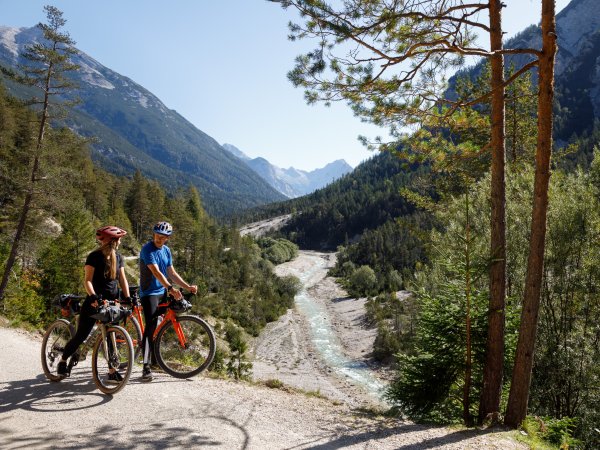And then this tree trunk lies in the middle of the path. I go out of the saddle, brake and think: All right, the Isarufer may be wild. But at the second trunk, a much larger, over which we must heave our wheels past the brush, I become skeptical: Where the hell are we here? My doubts become certainty. We are lost. Completely lost. We should have just followed the course of the river. How could that happen?
The short answer is: Our bikes have made us first a lot of fun and then quite cocky.
The longer answer is this one:
24 hours earlier. On a morning that was already as sunny as summer and still as frosty as winter, my friend Elisabeth and I arrived in Scharnitz. The first regional train took bikes, luggage and two tired Munichers across the German-Austrian border into northern Tyrol. As the train door has closed, you can hear the Isar already from afar splashing.
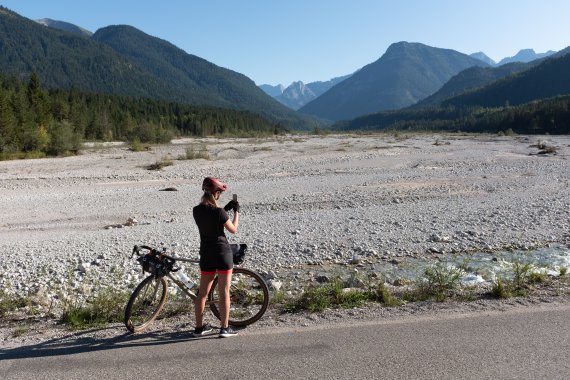
Until then I knew the Isar as a place of relaxation. In cold weather, to take walks along its wide banks in Munich. In heat, to barbecue and swim. The Isar, I'm sure, no other major city has such a beautiful river. But isn't it also a bit superficial to always experience only the end product, in this case the tamed city river? I want to find out whether you can only have fun with the Isar when you relax on its banks. Or even if you struggle on the bike next to her.
The river initially has a competitive advantage, because it only has to move downhill. We, on the other hand, have to go to its origin first uphill from Scharnitz. We soon need the smallest of the ten available gears. Our bikes are Gravelbikes, and from what I've been told, the run of the Isar offers the perfect terrain to really experience the benefits of this trendy bike.
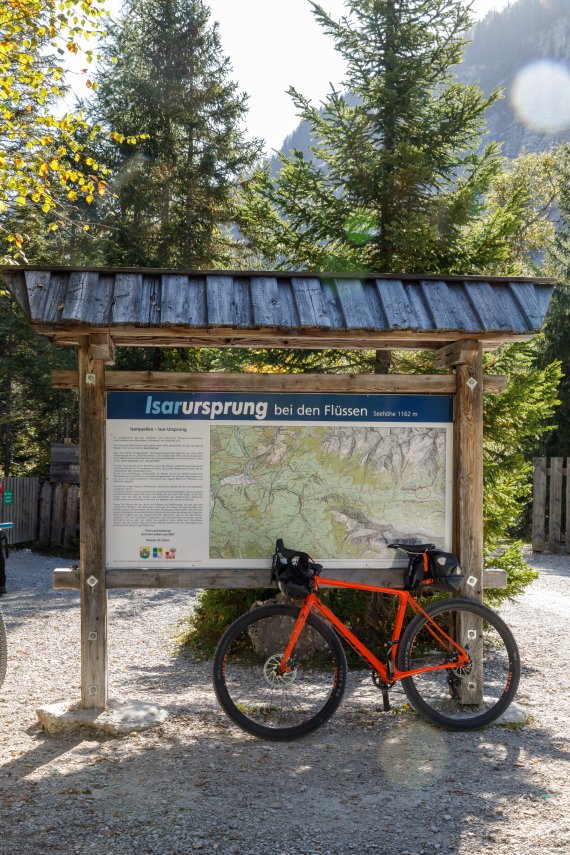
Gravel bikes have a sporty frame, similar to road bikes, they weigh little more than a medium-sized backpack, our models not even 10 kilos. That's a good third less than a full-suspension mountain bike. At the same time, they are much more comfortable than classic cross racers, which for decades were made only for competitions and on which you sit so streamlined that you get back pain just from watching.
Gravel bikes, however, combine the best of two worlds: The road bike ergonomics along with extra-light frame to get rolling properly. The quite thick profile tires to climb without problems and over every root and bump to be able to simply rush away.
150 kilometers lie ahead from the source to the city limits. With the road bike, the route would mean: Federal highway, weekend traffic, noise, exhaust fumes. With the mountain bike the distance would be a test of endurance - and the then nevertheless over large parts flat terrain an underchallenge. But with the Gravelbike this is a perfect tour, even for beginners. In addition, it goes from the source all the time downhill. At least that's what we thought.
On the first climb, the properties of the wheels pay off. The path leads properly purely into the Karwendel, from the forest road becomes a narrow mountain path, our tires gnaw on gravel and lumps of stone. But they never spin. We roll uphill, find the right footing. Sometimes the Isar flows around us from the left and right at the same time. Sometimes we see them fifty meters below us, marvel from afar, as it rushes on their first kilometers from the mountains.
We kick the wheels leisurely on, there is no extra weight, no suspension fork, no downhill frame that spoils the climb for us. After a good hour we arrive at the source. The Isar ripples peacefully along. It rises in various places and consists here of little more than a good dozen narrow rivulets. We fill our bottles with ice-cold spring water. Then it goes downhill and the real tour begins.
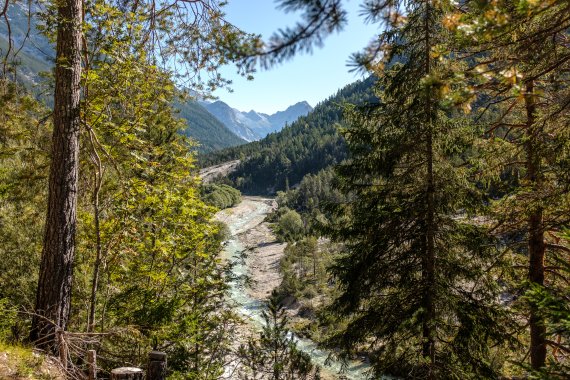
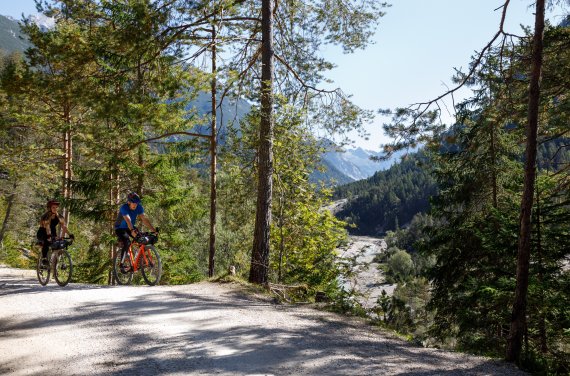
Meanwhile, it is noon, the sun is higher. On the descent it is still cool, but with the first short counter ascents I come quite nicely into a sweat. A leaf drifts on the still young river, I follow him and want to keep his pace - but already at the next bend it swims away. First realization: better no chases. Instead, it's better to let it drift, just like the water in the Isar does. We drive along a stretch of asphalt, over which our bikes whiz away. 35 kilometers per hour and more. Then it's off to the plain covered in gravel and Isar gravel. Only now and then the turquoise of the Isar shimmers through to us.
We are making good progress. While we roll side by side, we can talk relaxed. For example, about how narrow saddles actually need getting used to. In Mittenwald then finally the first intermediate destination. The terrace of a cozy Bavarian inn. We bend our heads over our plates. Cheese spaetzle for me, spinach dumplings for Elisabeth. 1200 kilocalories, my GPS watch reports, I have supposedly already burned. All the more courageously I empty my plate. And because the Radler now times Radler is called ... just.
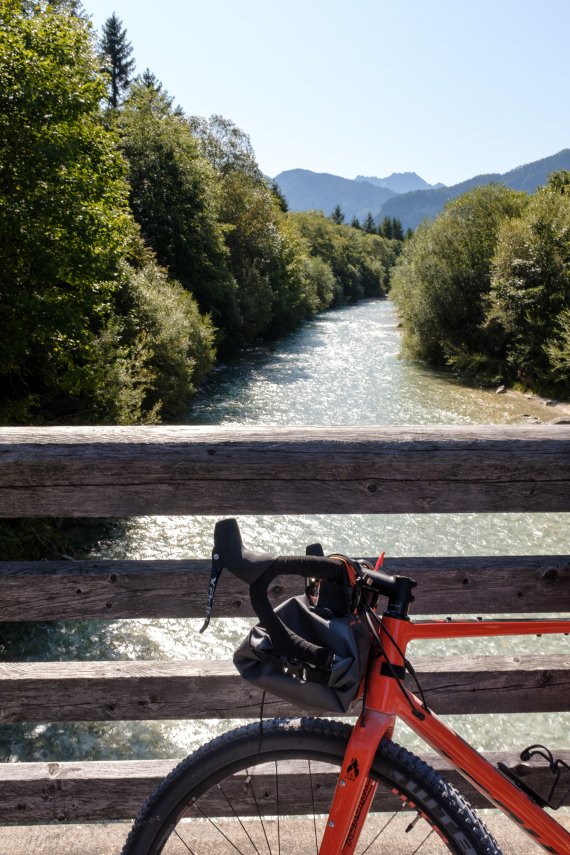
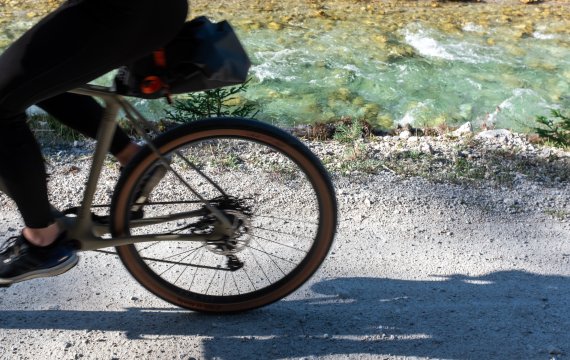
Our most important navigation system is the Isar itself. As long as we have its course in view or can at least hear it, we orient ourselves by its rushing and splashing. But sometimes that's not so easy. Most paths are not for bike tours on the banks, but for forestry work been created - correspondingly fast it goes at times away from the water and tends uphill.
Signs also do not always show the most beautiful or shortest way, which is why we prefer to ignore them. We let ourselves drift. In doubt downstream. It is a very honest way of traveling, we find.
And behind Krün comes what outdoor fans from the Munich area simply call "Little Canada". Sometimes vertically steep mountain sides, coniferous forests, a gigantically wide riverbed. No towns. Is this the Yukon or a river less than two hours' drive from Germany's third-largest city? While I'm thinking to myself, there s suddenly a turn that leads close to a rocky slope along and looks tempting.
After a short, hard climb, the Isar is suddenly quite far away. And where the Isar is far away, it becomes exhausting. In the lowest gear we pull up - and wait a minute: Are we about slower than the hikers in front of us? The Scarface theme song "Push it to the limit" runs through my head as a power song. I have to get out of the saddle for the first time. Behind me I hear Elisabeth, as she quietly sings "I'm still standing" by Elton John and continues to fight.
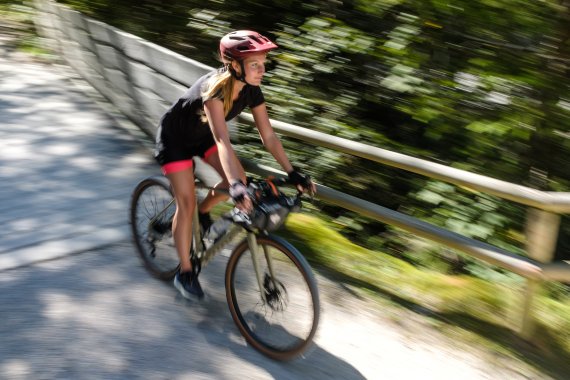
Up and down. Even more views of the wide Isar valley. And a stop at the gigantic Sylvenstein reservoir, which stores several million liters of water and protects the Isar communities as far as Munich from flooding. The reservoir has tamed the wild Isar, but the annual floods still turn it into an unpredictable river in which gravel banks and islands disappear within a few hours in the then murky floodwaters. The Sylvenstein protects against floods, but the Isar is still looking for their course and looks different every year.
At 1200 meters above sea level, we started at the origin. In Munich, we will arrive 700 meters closer to sea level. But the recurring climbs always make us forget that it is actually constantly going down. Nevertheless, it is good to know that now, in the late afternoon of the first day, we have the greatest altitude gain behind us, the wildest part of the route as well. We arrive in Lenggries in the early evening. Our tires are white as a sheet from all the chalky gravel. The sun is setting. Done, for today.
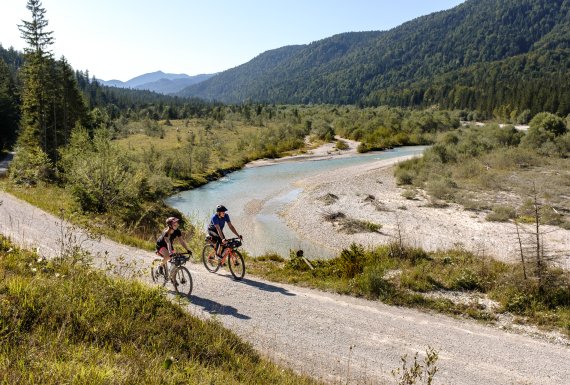
The next morning we drive over gravel roads past some game preserves, the Isar next to us in view. On the bank we refresh ourselves and discover a handful of fat trout, which seem to stand still in the current. With our bikes, Elisabeth and I roll at a constant pace over just about any surface, without noticing much.
With the mountain bike I have at home, I would be treading water. But with the Gravelbikes we make good progress even against the now rising north wind. The bikes roll. And they roll so easily that I hardly use the gear shift. In medium gears we roll quickly towards our goal. But the ease becomes a problem.
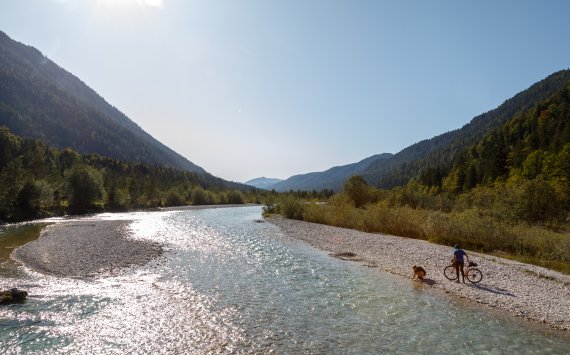
Once a piece of road becomes too boring for me and we have also lost sight of the Isar, I suggest turning onto a forest path, behind which, according to Google Maps, the Isar should flow. Elisabeth hesitates for a moment and then lets herself be convinced. The path quite quickly becomes a path and this path then becomes something that was once a path at some point, but is now definitely no longer a path. Far and wide no hiker, no mountain biker. Only fallen trees. We have to carry our bikes, which fortunately weigh hardly anything.
From the Isar is from here neither to hear nor to see anything, and the mood makes that not just better. Instead: Everywhere trees, standing and lying. I look at my cell phone. Google Maps has now apparently considered it differently and reveals that it goes from the location where we are right now, certainly not to Munich.
So we trust our senses again. After half an hour in the undergrowth and without orientation, we sit back on the saddle, sweaty from carrying and climbing. And for the first time we are glad that we have a country road in front of us. "Enough experiments," says Elisabeth and I'm pretty sure she has already looked at me more friendly.
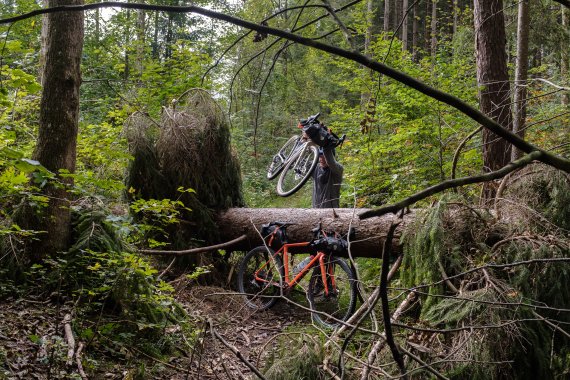
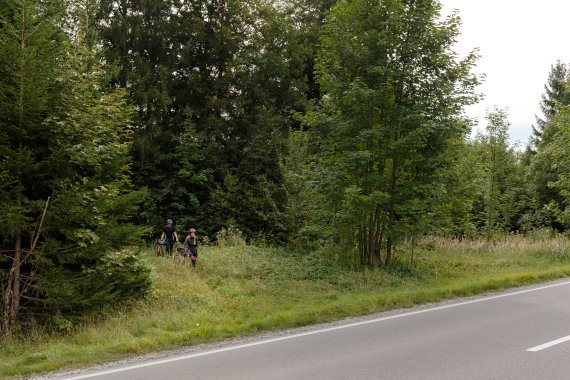
We have left the Alps behind us, and gradually the river valley seems so flat, as if the air had been let out of the landscape, like from a mattress. Conifers become deciduous trees. And from alpine peaks become church steeples and blocks of houses, first in Bad Tölz, then in Wolfratshausen and finally in Munich.
The wheels are dusted, and I imagine in my hands to see the imprints of the handlebars. Ten hours I held on to the grips, 150 kilometers we have done. For a ride along the river that combines the tough and the tame, gravel bikes are the perfect compromise. On passages with solid ground, we even roared past cyclists who looked like real pros. In the next moment, however, even the gravel on the dried riverbed is not a reason to turn around, but a feasible challenge. Had it not been for the fallen tree trunks, I would claim: With the Gravelbike you can get anywhere.
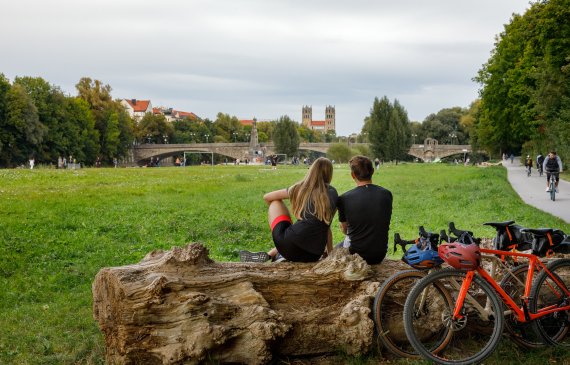
Exhausted and with pumped up thighs we sit at a small kiosk at the Wittelsbacherbrücke in Munich and toast to the tour. I wonder how many times the Isar has strayed, sped up, slowed down, polluted and purified itself on its way from its source to here? The Isar has come a long way. Just like us. On it another Radler.

 Sports BusinessSki Mountaineering Goes Olympic: What Milano-Cortina 2026 Means
Sports BusinessSki Mountaineering Goes Olympic: What Milano-Cortina 2026 Means
- ISPO awards
- Mountain sports
- Bike
- Design
- Retail
- Fitness
- Health
- ISPO Job Market
- ISPO Munich
- ISPO Shanghai
- Running
- Brands
- Sustainability
- Olympia
- OutDoor
- Promotion
- Sports Business
- ISPO Textrends
- Triathlon
- Water sports
- Winter sports
- eSports
- SportsTech
- OutDoor by ISPO
- Heroes
- Transformation
- Sport Fashion
- Urban Culture
- Challenges of a CEO
- Trade fairs
- Sports
- Find the Balance
- Product reviews
- Newsletter Exclusive Area
- Magazine
